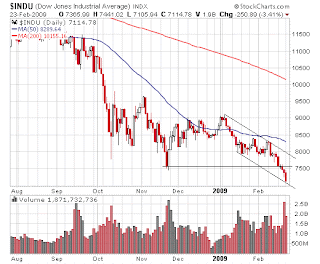No, the 2 trillion (2,000,000,000,000) is not my forecast for the Dow...haha! This is how much we could ended up adding to our national debt next week after the $780B stimulus package passed congress, and our treasury's TARP II bank bailout plan revealed.
The word is an additional $1 trillion is likely to be requested for the TARP II on top of the remaining $300B left from TARP I. If that is true, the bank bailout combined with the $780B stimulus package will bring the total in the range of $2T (so its not exactly $2T, what is a few tens of billion dollars here and there in comparison to the total amount we end up spending..sarcasm). We should start conditioning ourself to look at the T for trillion instead of all those zeros, because we will see the trillion more and more in the near future. And I'm sure the politicians would prefer it this way, it is less shocking to the public when they don't see all those zeros. After all, for each change in the letter, it is a thousand times more of the previous letter value (sorry if I have shocked you).
So, since we already know the lawmakers in DC really don't care what you or I think of all this, and they will do whatever they want to do. Rightfully or wrongfully, the tone in DC is that the debate is over and its time to do something.
What will this massive amount added to our national debt will do? Inflation is one sure thing it will create for our future. Looking at the 20+ years treasury bond fund ETF, TLT, you will see it has been falling since the beginning of the year.

Granted, the initial run up on this ETF is flight to quality. But now money is exiting in anticipation of higher inflation to come due to all these extra liquidity the world's central banks and governments are injecting into the global financial system. On the inverse, you will see money is moving into the TBT, an ETF that bet the rate on the long term treasury bond will go up (the price of the long term treasury bond will go down).

Then you look at the TIP, an ETF of the Barclay (formerly Lehman) TIPS bond fund is getting set to move higher. The TIPS is a treasury bond with principal adjusted for inflation. As inflation increase so does the principal and vice versa.

All these ETFs are telling us we are no longer worry about deflation (as we were back in October/November 2008), instead, our concern is on inflation. If I'm planning to hedge against inflation, I would be putting some money on TIPS and on gold by buying their respective ETF, TIP & GLD.











































